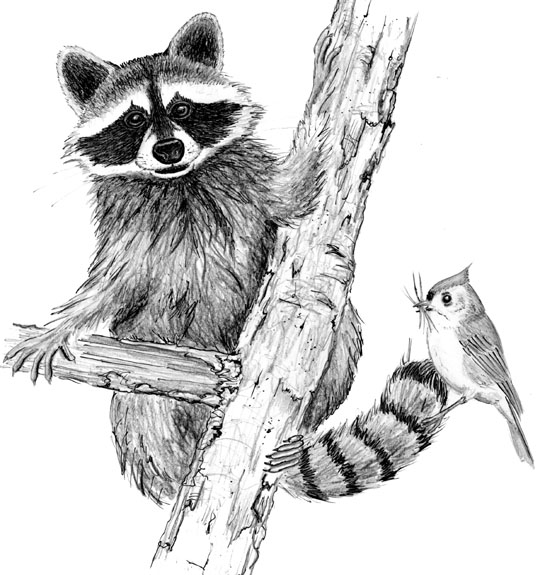
Dear Bird Folks,
At 7:00 PM yesterday evening, I heard my dogs barking at a raccoon that they had treed in our backyard. I was just about to take the dogs inside when a titmouse flew over and started attacking the raccoon. It kept flying at the raccoon, ripping out mouthfuls of its fur with each pass. These attacks went on for so long that I was able to get my camera and take the enclosed photo. Why was this titmouse so aggressive? Do you think it has a nest nearby?
– Bob, Orleans, MA
Great photo, Bob,
I really love this picture. That raccoon has a funny look on its face, like it is asking: “What is the story with this psycho bird?” It almost seems to be looking to you for help. Perhaps it wanted to make a deal with you, promising to never bother your feeders again if you can somehow get rid of that crazy titmouse. I sure hope you didn’t make the deal. Take it from me, and my chewed-up feeders, you can never trust a raccoon. They wear a mask for a reason.
Your suggestion about the titmouse defending its nest makes good sense. Once discovered, a bird’s nest will quickly become a drive-up window for a hungry raccoon. However, I don’t think that is what’s going on this time. If the raccoon was getting close to a nest it probably would have been attacked by both parents, along with reinforcements from every neighboring chickadee, Blue Jay and perhaps even a crow or twelve.
This may be hard to believe, but I actually think the raccoon was the victim here. Raccoon fur is super soft; just ask any grandmother who has a misguided sense of fashion. Animal fur certainly doesn’t belong on a coat, but it makes a great nest lining and keeps baby birds warm and cozy. The titmouse was merely “feathering” its nest with a bit of raccoon fur. And unlike a grandmother’s coat, the fur the titmouse was taking didn’t have the telltale fragrance of mothballs.
Many birds use mammal fur to line their nests. Usually, they pluck the fur from roadkill, or something that isn’t capable of protesting, but not always. One summer night I thought it would be cool to sleep out under stars. You know, one of those ideas that seemed like a good idea at the time but wasn’t. In the morning, while I was still sleeping, I could feel something tugging on my head. As I feebly swatted it away with my sleepy arms, I could see a chickadee sitting on my dew-soaked pillow with a beakfull of my hair. I screamed: “Come on, chickadee, not my hair. I’m having enough trouble holding onto my hair without you stealing it.” The chickadee wasn’t interested in my problems.
Last week a customer gave me a plastic bag full of fur that her golden retriever had shed. (I never would have guessed that goldens shed, but evidently they do.) I chopped a few holes in the bag and hung it out. Within minutes the birds where pulling out the fur for their nests. Retriever fur not only makes for a comfortable nest, but what predator wants to get near something that smells like a dog? Speaking of smells, another nice customer, who repairs violins for a living, gave us a bag of used horsetails. (Apparently, horsetails are used to make violin bows; at least that’s what he claims.) Baltimore Orioles love to use the tails to build their hanging nests. If, for some reason, you don’t have access to used horsetails, the birds will also take short pieces of yarn, twine, or an old string bikini that you aren’t using anymore.
Another great way to help nesting birds, that doesn’t involve any fur, is to offer them some lovely mud. A few birds, including robins and barn and cliff swallows, use lots of mud in their nests. They would be thrilled if you allowed a patch of your garden to become nice and muddy for them to scoop up. Tree swallows, on the other hand, aren’t into the mud scene. Instead, they have a white feather fetish. To make Tree swallows happy, try this: Each evening, after you have your nightly pillow fight, gather up all the loose feathers and put them outside. The swallows will literally attack each other trying to collect the feathers. No one is really sure why the swallows crave white feathers, but they sure make for a stately nest. On the weirder side of nest-building are the Great-crested Flycatchers. They like to line their nets with, of all things, dried snakeskin. Again, no one is sure why. Perhaps flycatchers practice a little Voodoo on the side. If your supply of snakeskin is running low, or you don’t like the idea of supporting Voodoo, try putting out strips of waxed paper. The flycatchers will sometimes use waxed paper as a less creepy substitute.
Thanks again for that great picture, Bob. It’s the best one of the spring. And don’t worry about the raccoon. It may not be happy about donating to the titmouse’s nest, but its hair will grow back. Too bad I can’t say the same thing about my own.